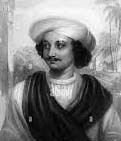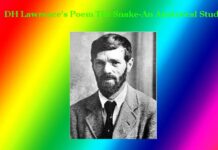The Poetry of Kasiprasad Ghose-Chief Features
The Poetry of Kasiprasad Ghose-Chief Features
The Poetry of Kasiprasad Ghose-Chief Features
It is generally said that Henry Derozio was the first Indian poet who wrote poetry in English. But he was not an aborigine of India because he came off of mixed Portuguese and Indian descent. It was Kasiprasad Ghose (1809-1873) who was the first pure Indian who wrote poetry in English because he was an aboriginal Indian descent. On the other hand, the themes and style of Henry Derozio’s poetry were half English and half Indian. But both the themes and style of Kasiprasad Ghose were pure Indian, except only language. Both in matter and manner, he was full of Indian sensibilities. He wrote on Indian blind faith, Indian natural scenery, Indian wild being, and so on.
‘To a Young Hindu Widow’ is a poem in which he has expressed the sorrows and sufferance, social negligence and hatred suffered by an Indian widow. In Indian society till the time of Kasiprasad Ghose, a Hindu widow could not enter into a second marriage and all her remaining life she had to suffer inestimable social hatred and negligence. She had to give up all the joys and comforts of life. Her widowhood was a living tragedy; a living death. Her sorrows and sufferance ended in her death only. The poet writes:
”Thou mayst not, dar’st not, must not hope
A joy upon the world beneath;
But thou must ev’r with sorrow’s cope,
Sorrows which only end in death.”
The Poetry of Kasiprasad Ghose-Chief Features
Till Kasiprasad Ghose, there were poets and poets in India, but none seemed to portray the sufferance of a widow in poetry.
‘The Shair’s Farewell Song’ is another poem in which the poet portrays the natural beauty as well as his love and praise for the natural beauty of India. In this poetry, the poet says that an individual whose title is ‘Shair’, goes to the sea, being grief-worn, to make an end to his life as to get rid of his grief. But before jumping down to the sea to commit suicide, he climbs up the rock beside the sea to enjoy the natural scenery of his motherland and sings a song in praise of her beauty. The description of the beauty of his land is realistic and heart-penetrating. He sings:
”Farewell my lovely native land!
Where roses bloom in many a vale;
Where green clad hills majestic stand
Where flowers woo the scented gale
……………………………………
Where mighty Ganga’s billows flow
And wonder many a country by
Where ocean smiles serene below,
Beneath thy blue and sunny sky.”
The Poetry of Kasiprasad Ghose-Chief Features
To a Dead Crow is another individual poem in which the poet expresses his love for Indian wild beings. The crow is a wild bird. None heeds on the bird and its voice. Everybody hates it as an inauspicious bird. But for the poet, it is a “gay minstrel of the Indian clime”. In this poetry, the poet sympathizes with the crow. He writes:
”Gay minstrel! nev’r had death before
It’s dart destructive, sharpened more
To pierce a gayer, mortal heart
Than thine, which ah! hath felt the smart!”
The Poetry of Kasiprasad Ghose-Chief Features
There are poets who write poetry in praise of cuckoos, skylarks, and peacocks; but it was Kasiprasad Ghose who wrote poetry in praise of an ugly and inauspicious bird like a crow.
From the above discussion, it is clear that the main themes of Kasiprasad Ghose’s major poems are Indian and the sympathetic portrayal of these themes proves that he had a great love for his motherland. And hence he may be called a great patriotic Indo-Anglian poet.
Pathos is the main tone of his poems. All themes taken by him for his poetry are pathetic and thus pathos have been portrayed with sympathy and this sympathy is enough to prove him to be a great lover of his motherland with all its objects and beings.
The style of Kasiprasad Ghose is also Indian. Poets before him and even many poets after him wrote poetry imitating the style of the English poets. But Kasiprasad had written poetry not imitating the English poets but imitating the Indian style of the Bengali lyrics.
The imagery of his poetry is consciously free from the net of English imagery. He employs simple but native imagery and always keeps himself away from the complexity of the English imageries. His imageries are mainly visual. But here to say that though his imageries are simple, yet his portrayal of the fact, feeling or idea is so vivid that his readers experience it in such a manner as if it has been happening in front of our eyes. Like his imagery, there is not any complexity and difficulty in word and phrase formations.
At last, it is reasonable to come to the conclusion that Kasiprasad Ghose was the first Indo-Anglian poet whose poetry is replete with national sensibilities. 0 0 0
The Poetry of Kasiprasad Ghose-Chief Features
N.B. The article ‘The Poetry of Kasiprasad Ghose’ originally belongs to the book ‘Indian English Poets and Poetry-Chief Features‘ by Menonim Menonimus.
Books of Composition by M. Menonimus:
- Advertisement Writing
- Amplification Writing
- Note Making
- Paragraph Writing
- Notice Writing
- Passage Comprehension
- The Art of Poster Writing
- The Art of Letter Writing
- Report Writing
- Story Writing
- Substance Writing
- School Essays Part-I
- School Essays Part-II
- School English Grammar Part-I
- School English Grammar Part-II..
Related Search:











